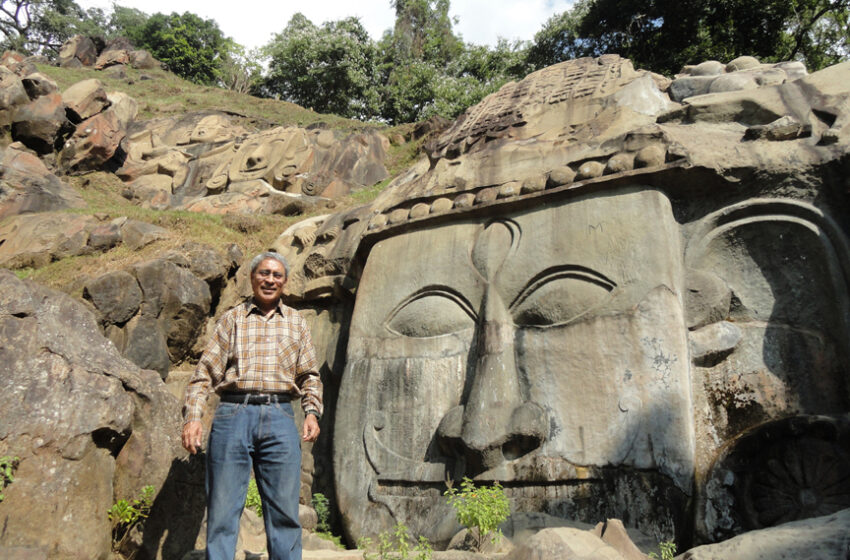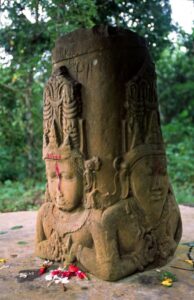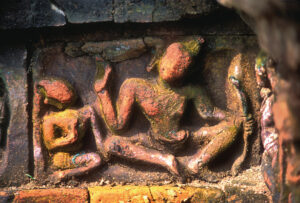Exploring Tripura, the verdant and vibrant land of forests and deities in Northeast

The writer at Unnakoti, Tripura
Benoy K Behl
Do you know that the largest rock-cut reliefs of Lord Shiva are in Tripura?
How many know that some of the earliest Buddhist Vajrayana depictions are found in a Pala period stupa in Tripura?
Or that Tripura is one of the great centers of the worship of Durga?
Tripura is a land of verdant hills and lush greenery. Travelling through Tripura is like taking a journey into thick forests. A sense of the eternal calm pervades the life of the people here and images of their devotion can be seen everywhere. This state has some of the greatest sites dedicated to Lord Shiva and Goddess Durga.
The tradition of living with nature is reflected in the beautiful handicrafts of Tripura, made using the bounty of nature available in the thick forests. It is also a crucible of early Indian culture, which continues till today, reminding us of the richness and glory of ancient India.
Unnakoti
Unnakoti (meaning ten million) has the largest Shiva rock-cut reliefs in all of India. This remote and magnificent site in the hills of North Tripura is one of the greatest sites of religious art in the country. These impressive sculptures were made in the 11th or 12th century, towards the end of the reign of the Palas.
The central Shiva face is known as the Unnakotisavara Kaal Bhairava, and including the head dress, it is over 30 feet high. The most enchanting part of this site is its magical setting in the middle of the thick forest.
We are dwarfed by these massive reliefs. For indeed that is the purpose to convey the awesome majesty of the spirit, which is far greater than the forms of the world around us.

Unnakoti also has massive rock-cut depictions of Durga and of other deities. In this enchanted place, the colossal sculptures blend with the natural beauty. Mukhalingas and beautiful sculptures of many other divinities are also found at Unnakoti. These indicate the existence of earlier temples here, prior to the rock- cut reliefs.
Buddhism
Along with Hinduism, Tripura was also an important centre of Buddhism. Evidence of Buddhism has been found, dating from the first decade of the Sixth Century AD onwards. Tantric Buddhism flourished here from the Eighth century onwards.
The remains of the Pilak Stupa are located in a very remote part of South Tripura. The exquisite relief on the stupa on the base of the stupa represents the Vajrayana school of Buddhism which was prevalent in Pala times, when the stupa was made. The Vajra of the Vajrayana School is a representation of a thunderbolt, for it was believed that the logic of this school of Buddhism was as striking as the thunderbolt. It was also believed to be as indestructible as a diamond.

The Vajrayana form of Buddhism developed in Eastern India, mainly at the universities of Nalanda and Vikramshila. In fact, the earliest representations we have of relief made along the base in this fashion is found at the site of Nalanda. These reliefs are also similar to those found in the base of the Pahar Pur stupa in Bangladesh. We also find Pala period reliefs carved in wood like this at the Charang monastery in Kinnaur.
This stupa is of great value in the study of Buddhism in the East of India. These reliefs are among the earliest art found in sites of the Vajrayana School of Buddhism. It was from Eastern India that this form of Buddhism spread to Myanmar, Nepal, Tibet and Indonesia.
Bronze sculptures have been found in the area around Pilak. These are of a very high artistic quality and are made in the style of the Pala period. It is believed that Pilak may have many more treasures to offer and excavations are being carried out in the area.
In ancient and early medieval times, the worship of Shiva and Shakti was wide-spread, all over the North-East.
Tripura Sundari Temple
Regarded as one of the 51 pithasthanas of Hindu pilgrims in India, the temple of Tripureswari or Tripura Sundari is in the town of Udaipur, about 56 kms South of Agartala. She is a form of Durga and is the most revered deity of Tripura. The state has got its name from this Goddess.
Legend has it that king Dhanyamanikya, who ruled Tripura in the end of the 15th century, had a revelation one night in a dream. In the dream, he was told to install the image of Tripura Sundari in a temple that stood on a hilltop near the town of Udaipur. The temple came up in 1501. Over 2,000 worshippers visit this temple daily.
The temple has a square type sanctum, made in the style, of a typical Bengali hut, with a conical dome.
Tripura Sundari is also called Shodashi (Vermilion-hued), Lalita (the Playful One) and Rajarajeshvari (Queen of Queens). In Hindu mythology, Lord Vishnu had cut the body of Parvati in the form of Sati into 51 pieces with his Sudarshan Chakra. These pieces fell in different places throughout the country. These places came to be deeply revered and are known as Pithasthans. It is believed that her right foot fell here in Matabari. The deity Tripura Sundari combines in her being Kali’s determination, Parvati’s charm and Durga’s grace.
Kali is the embodiment of eternal energy. It is this energy with which we must battle the demons of our ignorance. In Indian thought, the only evil is our lack of true knowledge, our confusion. We remain caught in the spell of ‘Maya’ or ‘Mithya’, the illusions of the world of forms around us. Thus, we are blinded to the truth.
Be a part of an enthralling journey to the Tripura.
India Habitat Centre is presenting a talk and film
screening of ‘Ancient Land of Tripura on
November 20 at 6pm
Register here

